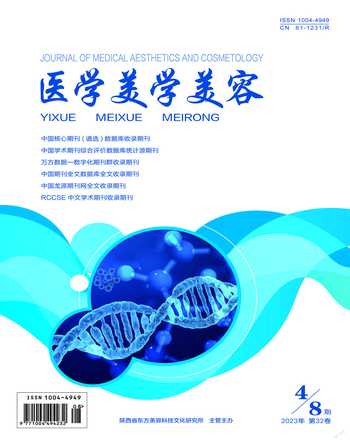癌源性细胞外囊泡在皮肤鳞状细胞癌诊疗中的研究进展
杨雪滢 李东霞 廉琛
【摘 要】皮肤鳞状细胞癌(CSCC)是世界上最常见的癌症之一,尽管CSCC通常预后良好,但部分患者表现为局部复发、淋巴结转移、远处转移等,故积极寻求CSCC新的诊断及治疗方法具有重要意义。细胞外囊泡(EV)是富含蛋白质、核酸、脂质等生物活性物质,通过介导细胞间通讯,在机体的生理和病理过程中发挥重要作用。EV与皮肤鳞状细胞癌的发生发展密切相关,是皮肤鳞癌早期诊断、靶向治疗的潜在标志物。本文对CSCC源性EV生物发生及其在CSCC诊断、预后、治疗中的研究进展作一综述,旨在探讨EV在CSCC临床诊断和治疗中的潜在价值。
【关键词】皮肤鳞状细胞癌;细胞外囊泡;Dsg2;RNA;P38
中图分类号:R739.5 文献标识码:A 文章编号:1004-4949(2023)08-0172-04
Research Progress of Cancer-derived Extracellular Vesicles in the Diagnosis and Treatment of Cutaneous Squamous Cell Carcinoma
YANG Xue-ying1,2, LI Dong-xia1, LIAN Chen1,2
(1.Department of Dermatology and Venereal Disease, Affiliated Hospital of Inner Mongolia Medical University, Hohhot 010110, Inner Mongolia, China; 2.Graduate School of Inner Mongolia Medical University, Hohhot 010110, Inner Mongolia, China)
【Abstract】Cutaneous squamous cell carcinoma (CSCC) is one of the most common cancers in the world. Although CSCC usually has a good prognosis, some patients show local recurrence, lymph node metastasis, distant metastasis, etc. Therefore, it is of great significance to actively seek new diagnosis and treatment methods for CSCC. Extracellular vesicles (EVs) are rich in proteins, nucleic acids, lipids and other bioactive substances, which play an important role in the physiological and pathological processes of the body by mediating intercellular communication. EV is closely related to the occurrence and development of skin squamous cell carcinoma, and is a potential marker for early diagnosis and targeted therapy of skin squamous cell carcinoma. This article reviews the research progress of CSCC-derived EV biogenesis and its role in the diagnosis, prognosis and treatment of CSCC, aiming to explore the potential value of EV in the clinical diagnosis and treatment of CSCC.
【Key words】Cutaneous squamous cell carcinoma; Extracellular vesicles; Dsg2; RNA; P38
皮肤鳞状细胞癌(cutaneous squamous cell carcinoma,CSCC)是临床第二常见的非黑素性皮肤肿瘤,临床发病率高。虽然通常通过及时手术切除可以治愈,但大多数患者在确诊时往往已是癌症晚期,治疗效果不佳、复发率高、预后差[1-3]。CSCC的危险因素有长期紫外线辐射、慢性溃疡、皮肤慢性炎症等[4-6]。细胞外囊泡(extracellular vesicle,EV)[7]是细胞经过“内吞-融合-外排”等一系列调控过程而形成的膜性囊泡,肿瘤细胞是EVs的积极生产者,癌源性EVs通过自分泌或旁分泌方式携带蛋白质、基因等转运维持肿瘤生长所需的因子,从而介导肿瘤细胞与周围基质组织之间的通信,参与癌症的发展、免疫逃逸、转移和耐药。与循环肿瘤细胞(circulating tumor cells,CTCs)和无细胞DNA(cfDNA)相比,EV具有较好的微创性、稳定性和组织相容性,使其在癌症液体活检中可作为新的生物标志物[8]。研究显示[9],癌源性EVs在CSCC的早期诊断、预后和治疗中具有巨大的临床应用潜力。本文就癌源性细胞外囊泡在皮肤鳞状细胞癌诊疗中的研究进展进行综述,以期为其临床诊疗提供参考。
EV是直径为30~150 nm且具有脂质双分子层的膜性囊泡,根据其来源和大小可分为微囊泡、凋亡小体、外泌体,其主要成分包含外泌体(exosomes)。EVs可由多种人体细胞(包括肿瘤细胞)分泌并且在血液、尿液、唾液和其他体液中均可检测到[10]。EVs含有来自其母细胞的选择性结合分子,包括CD9、RNA(例如mRNA、miRNA、circRNA)、DNA和脂质[11]。Desmoglin 2(Dsg2)是桥粒体细胞-细胞粘附结构的组成部分,存在于所有上皮来源细胞中,具有上皮细胞间充质转化、细胞增殖和迁移等多种生物学功能[12]。已有研究表明[13,14],Dsg2在EV的生物发生、调节和生物学功能中起着关键作用。Flemming JP等[15]发現过表达棕榈酰化Dsg2的A431-Dsg2/GFP肿瘤细胞中EV的释放量增加了2倍。50 μM-溴棕榈酸盐(一种不可逆的棕榈酰酰基转移酶抑制剂)和Dsg2cacs转染减轻了Dsg2的影响,从而消除了Dsg2的棕榈酰化。此外,免疫受损小鼠的A431-Dsg2/GFP异种移植导致肿瘤生长显著加快和血浆EV水平升高,单剂量20 μg Dsg2调制的EV能够增强A431-GFP异种移植的致瘤潜力。Overmiller AM等[16]证实Dsg2过表达增加了细胞分泌EV和EV相关蛋白密度。此外,用靶向Dsg2的shRNA转导A431-Dsg2/GFP细胞可减弱这种效应。由此说明,Dsg2是EV生物发生有效的调节物质。
近年来EV作为液体活检的一种无创诊断工具活跃于肿瘤学研究领域,将基于EV的液体活检用于某些高危患者的筛查和鉴别可能有助于早期发现并避免不必要的组织活检。一项涉及139例早期胰腺癌、卵巢癌或膀胱癌癌症患者的研究显示[11],使用基于细胞外囊泡蛋白的诊断性血液测试,曲线下的面积为0.95(敏感性71.2%,特异性99.5%)。EV RNA还可以检测非小细胞肺癌并与小细胞肺癌相鉴别[17]。根据已有的研究结果,本文选择CSCC中具有诊断潜力的两种RNA分子(Ct-SLCO1B3和circ-CYP24A1)展开讨论。
2.1 Ct-SLCO1B3 由于皮肤反复损伤,隐性遗传营养不良型大疱性表皮松解症(RDEB)患者更容易发生侵袭性CSCC。Sun Y等[18]分析了体外培养的RDEB肿瘤和非RDEB肿瘤EV中肿瘤标志物基因Ct-SLCO1B3的表达,结果显示CtSLCO1B3仅在RDEB-SCC源性EV中表达,而在非癌性RDEB角质形成细胞源性EV中不表达。由此说明,检测EVs中的Ct-SLCO1B3的表达是临床诊断RDEB患者是否发生侵袭性CSCC的一个很有前景的诊断生物标志物。同时,有必要对CtSLCO1B3在患有CSCC的非RDEB患者的EV中的普遍性进行更多的研究。
2.2 Circ-CYP24A1 Zhang Z等[19]使用RNA测序(RNA-seq)对CSCC患者血清中的外泌体环状RNA(circRNA)进行分析。与健康受试者相比,共检测到7577种circRNA,其中25个表达上调,76个下调。这些circRNA构成了2个独特的RNA簇:介导T细胞和NK细胞细胞毒性的基因和MHC蛋白复合物增强,而调节中心碳代谢、细胞成分组织和细胞周期的基因减少。而在第1簇中,circ-CYP24A1的增加程度最大。同时由于环状结构赋予RNase抗性使其在介导细胞通讯时能够稳定存在,所以circ-CYP24A1被认为是CSCC的理想生物标志物[19],有望为CSCC治疗提供新靶点。
随着外泌体分离技术的敏感性提高,了解CSCC源性EV中特定存在的蛋白质和基因有望成为肿瘤预防中有价值的生物标志物。已有研究表明[20],黑色素瘤源性EV上的PD1和PD-L1表达可预测检查点抑制剂的耐药性;EV mRNA可预测非小细胞肺癌(NSCLC)的生存期及不同治疗方式的疗效[17]。此外,EV DNA同时反映了原发肿瘤的染色体和线粒体DNA,可作为评估肿瘤基因组和预测预后的有力工具。
3.1 p38抑制的CSCC相关长基因间非编码RNA(linc-PICSAR) Wang D等[21]探讨了lnc PICSAR在顺铂耐药CSCC和HSC-5细胞患者中的作用。与健康个体和顺铂敏感HSC-5细胞相比,观察到从顺铂耐药的CSCC患者和细胞系的中提取的EV中lnc-PICSAR的数量显著增加。lnc PICSAR通过抑制miR-485-5p直接参与顺铂耐药性,进而促进REV3L基因表达。因此,CSCC患者血清源性EV中lnc PICSAR的浓度可指导化疗方案的选择。
3.2 circ-CYP24A1 Zhang Z等[19]假设异常表达的EV circ-CYP24A1在CSCC中具有致瘤作用,通过观察到A431和SCL-1细胞摄取circ-CYP24A1与pkh67标记的EV共培养支持这一假设。发现circCYP24A1除具有诊断价值外,与肿瘤厚度呈微正相关(r=0.8689,P=0.0558),此外,转染sicirc-CYP24A1的EV可敲除circ-CYP24A1,从而抑制CSCC细胞的增殖、迁移和侵袭,最终诱导细胞凋亡。
3.3 DNA拷贝数改变(CNA) Nguyen B等[22]对2例转移性CSCC患者和3例转移性舌基SCC患者进行了低覆盖全基因组测序(FFPE)和血清EV DNA检测。与粘膜SCC相比CSCC显示更多的CNAs(25 vs 11.3个区域;1.225×109对4.433×108基对)和更多的FFPE CNAs重叠(16vs3个区域;3.25×108 vs 3.267×108基对)。尽管大多数CNA是缺失的,但EV-DNA中的重复区域可能更能反映FFPE-DNA中的突变。在两个样本中都发现了Chr 7p、8q和20q的重复,并且与已发表的侵袭性CSCC突变图谱一致[24]。但是,由于EV-DNA来源于肿瘤和非肿瘤DNA,不同患者之间FFPE和EV-DNA相关性存在相当大的异质性。因此,是否可以使用EV的CNA谱来准确检测转移性SCC,还需要更多的研究来验证。
EV膜分子的共价和非共价修饰可以增强与靶细胞的特异性结合。这些外部修饰的EV已被用于在胶质母细胞瘤、乳腺癌等模型中输送治疗药物[24,25]。在Overmiller AM等[16]研究中,当人成纤维细胞与A431-Dsg2/GFP细胞共培养时,成纤维细胞GFP阳性比A431-GFP细胞多55%,这表明Dsg2可能促进EV的摄取。因此,EV Dsg2修饰可以改善对CSCC微环境的治疗效果。鉴于Dsg2在CSCC源性EV生物发生和功能中的重要性,靶向Dsg2翻译的miRNA可能成为新的CSCC治療靶点,对药物开发具有重要意义。
肿瘤源性EV中的生物标志物包括DNA、RNA和表面相关蛋白,这些生物标志物可促进准确的临床诊断并提示癌症预后。本文提到的研究已证实了CSCC源性EV Ct-OATP1B3 mRNA、circ-CYP24A1、linc-PICSAR和DNA CNA等靶分子的诊断和治疗潜力,由于实验数据有限,需要进一步研究EV在CSCC病理生理中的作用以及CSCC源性EV的临床相关性,以确立EV在CSCC诊断和治疗中的临床应用价值。
[1] Que SKT,Zwald FO,Schmults CD.Cutaneous squamous cell carcinoma:Incidence,risk factors,diagnosis,and staging[J].J Am Acad Dermatol,2018,78(2):237-247.
[2] Fremlin GA,Bray AP,de Berker DA.Clinical triage of cutaneous squamous cell carcinoma and basal cell carcinoma to avoid treatment delay:value of an electronic booking system[J].Clin Exp Dermatol,2014,39(6):689-695.
[3] Stratigos A,Garbe C,Lebbe C,et al.Diagnosis and treatment of invasive squamous cell carcinoma of the skin:European consensus-based interdisciplinary guideline[J].Eur J Cancer,2015,51(14):1989-2007.
[4] Thompson AK,Kelley BF,Prokop LJ,et al.Risk Factors for Cutaneous Squamous Cell Carcinoma Recurrence,Metastasis,and Disease-Specific Death:A Systematic Review and Meta-analysis[J].JAMA Dermatol,2016,152(4):419-428.
[5] Hogue L,Harvey VM.Basal Cell Carcinoma,Squamous Cell Carcinoma,and Cutaneous Melanoma in Skin of Color Patients[J].Dermatol Clin,2019,37(4):519-526.
[6] Tokez S,Venables ZC,Hollestein LM,et al.Risk factors for metastatic cutaneous squamous cell carcinoma:Refinement and replication based on 2 nationwide nested case-control studies[J].J Am Acad Dermatol,2022,87(1):64-71.
[7] Doyle LM,Wang MZ.Overview of Extracellular Vesicles,Their Origin,Composition,Purpose,and Methods for Exosome Isolation and Analysis[J]. Cells,2019,8(7):727.
[8] Wu JY,Li YJ,Hu XB,et al.Preservation of small extracellular vesicles for functional analysis and therapeutic applications a comparative evaluation of storage conditions[J].Drug Deliv,2021,28(1):162-170.
[9] Lee IT,Shen CH,Tsai FC,et al.Cancer-Derived Extracellular Vesicles as Biomarkers for Cutaneous Squamous Cell Carcinoma:A Systematic Review[J]. Cancers (Basel),2022,14(20):5098.
[10] Kumeda N,Ogawa Y,Akimoto Y,et al.Characterization of Membrane Integrity and Morphological Stability of Human Salivary Exosomes[J].Biol Pharm Bull,2017,40(8):1183-1191.
[11] Hinestrosa JP,Kurzrock R,Lewis JM,et al.Earlystage multi-cancer detection using an extracellular vesicle protein-based blood test[J].Commun Med(Lond),2022,2:29.
[12] Sch?fer S,Koch PJ,Franke WW.Identification of the ubiquitous human desmoglein,Dsg2,and the expression catalogue of the desmoglein subfamily of desmosomal cadherins[J].Exp Cell Res,1994,211(2):391-399.
[13] Brennan-Crispi DM,Overmiller AM,TamayoOrrego L,et al.Overexpression of Desmoglein 2 in a Mouse Model of Gorlin Syndrome Enhances Spontaneous Basal Cell Carcinoma Formation through STAT3-Mediated Gli1 Expression[J].J Invest Dermatol,2019,139(2):300-307.
[14] Overmiller AM,McGuinn KP,Roberts BJ,et al.c-Src/ Cav1-dependent activation of the EGFR by Dsg2[J].On cotarget,2016,7(25):37536-37555.
[15] Flemming JP,Hill BL,Haque MW,et al.miRNAand cytokine-associated extracellular vesicles mediate squamous cell carcinomas[J].J Extracell Vesicles,2020,9(1):1790159.
[16] Overmiller AM,Pierluissi JA,Wermuth PJ,et al.Desmoglein 2 modulates extracellular vesicle release from squamous cell carcinoma keratinocytes[J].FASEB J,2017;31(8):3412-3424.
[17] Duréndez-Sáez E,Torres-Martinez S,Calabuig-Fari?as S,et al.Exosomal microRNAs in non-small cell lung cancer[J].Transl Cancer Res,2021,10(6):3128-3139.
[18] Sun Y,Woess K,Kienzl M,et al.Extracellular Vesicles as Biomarkers for the Detection of a Tumor Marker Gene in Epidermolysis Bullosa-Associated Squamous Cell Carcinoma[J].J Invest Dermatol,2018,138(5):1197-1200.
[19] Zhang Z,Guo H,Yang W,et al.Exosomal Circular RNA RNA-seq Profiling and the Carcinogenic Role of Exosomal circ-CYP24A1 in Cutaneous Squamous Cell Carcinoma[J].Front Med (Lausanne),2021,8:675842.
[20] Serratì S,Guida M,Di Fonte R,et al.Circulating extracellular vesicles expressing PD1 and PD-L1 predict response and mediate resistance to checkpoint inhibitors immunotherapy in metastatic melanoma[J]. Mol Cancer,2022,21(1):20.
[21] Wang D,Zhou X,Yin J,et al.Lnc-PICSAR contributes to cisplatin resistance by miR-485-5p/REV3L axis in cutaneous squamous cell carcinoma[J].Open Life Sci,2020,15(1):488-500.
[22] Nguyen B,Wong NC,Semple T,et al.Low-coverage whole-genome sequencing of extracellular vesicleassociated DNA in patients with metastatic cancer[J]. Sci Rep,2021,11(1):4016.
[23] Pickering CR,Zhou JH,Lee JJ,et al.Mutational landscape of aggressive cutaneous squamous cell carcinoma[J].Clin Cancer Res,2014,20(24):6582-6592.
[24] Li Y,Gao Y,Gong C,et al.A33 antibody-functionalized exosomes for targeted delivery of doxorubicin against colorectal cancer[J].Nanomedicine,2018,14(7):1973-1985.
[25] Li S,Wu Y,Ding F,et al.Engineering macrophage-derived exosomes for targeted chemotherapy of triple-negative breast cancer[J].Nanoscale,2020,12(19):10854-10862.
編辑 张孟丽

